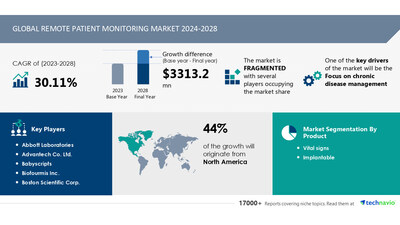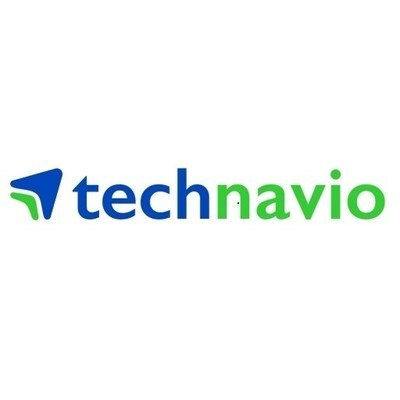Remote Patient Monitoring Market to Expand by USD 3.31 Billion (2024-2028), Focus on Chronic Disease Management, AI-Powered Market Evolution - Technavio
NEW YORK, Nov. 26, 2024 /PRNewswire/ -- Report on how AI is driving market transformation - The global remote patient monitoring market size is estimated to grow by USD 3.31 billion from 2024-2028, according to Technavio. The market is estimated to grow at a CAGR of almost 30.11% during the forecast period. Focus on chronic disease management is driving market growth, with a trend towards iot in healthcare. However, lack of reimbursement policies for remote monitoring poses a challenge.Key market players include Abbott Laboratories, Advantech Co. Ltd., Babyscripts, Biofourmis Inc., Boston Scientific Corp., Caretaker Medical NA, Dragerwerk AG and Co. KGaA, GE Healthcare Technologies Inc., Honeywell International Inc., Koninklijke Philips N.V., Masimo Corp., Medtronic Plc, MphRx Inc., Napier Healthcare Solutions Pte Ltd., Nihon Kohden Corp., OMRON Corp., OSI Systems Inc., OSP, Shenzhen Mindray BioMedical Electronics Co. Ltd, Siemens AG, Smiths Group Plc, and VitalConnect Inc..
AI-Powered Market Evolution Insights. Our comprehensive market report ready with the latest trends, growth opportunities, and strategic analysis- View Free Sample Report PDF
Forecast period | 2024-2028 |
Base Year | 2023 |
Historic Data | 2018 - 2022 |
Segment Covered | Product (Vital signs and Implantable), End-user (Hospitals, ASCs, and Home care), and Geography (North America, Europe, Asia, and Rest of World (ROW)) |
Region Covered | North America, Europe, Asia, and Rest of World (ROW) |
Key companies profiled | Abbott Laboratories, Advantech Co. Ltd., Babyscripts, Biofourmis Inc., Boston Scientific Corp., Caretaker Medical NA, Dragerwerk AG and Co. KGaA, GE Healthcare Technologies Inc., Honeywell International Inc., Koninklijke Philips N.V., Masimo Corp., Medtronic Plc, MphRx Inc., Napier Healthcare Solutions Pte Ltd., Nihon Kohden Corp., OMRON Corp., OSI Systems Inc., OSP, Shenzhen Mindray BioMedical Electronics Co. Ltd, Siemens AG, Smiths Group Plc, and VitalConnect Inc. |
Key Market Trends Fueling Growth
Remote Patient Monitoring (RPM) is a trending business in healthcare, enabling patient-centered care and personalized medicine through real-time health data collection. RPM caters to patient engagement, especially for geriatric demographics and those with chronic ailments, reducing healthcare expenditures and enabling aging in place. Regulatory variations, social media practices, and telemedicine start-ups influence RPM's growth. RPM technologies include IoT medical devices, telemedicine apps, and software solutions. Reimbursement policies, behavioral barriers, and healthcare fraud are challenges. RPM addresses infectious diseases, epidemics, and healthcare-associated infections, with devices like vital sign monitors and special monitors for heart rate, blood pressure, and glucose levels. Firms like EPIC Health and Disease Control Prevention (CDC) use RPM for chronic disease management. Medical practitioners, hospitals, and healthcare organizations benefit from RPM's remote access and digital platforms. RPM technologies ensure quality of care, prevent healthcare fraud, and improve consultation tools for healthcare consumers.
The remote patient monitoring market is experiencing significant growth due to the increasing adoption of Internet of Things (IoT) technology and connected medical devices in the healthcare industry. IoT bridges the gap between physical and digital data sources, enabling real-time patient monitoring and improving accessibility to healthcare services. This trend is helping healthcare organizations reduce operational burdens and develop digital ecosystems, ultimately leading to timely and improved patient care. The potential applications of IoT in healthcare settings are vast, extending beyond inpatient services to outpatient care as well.
Insights on how AI is driving innovation, efficiency, and market growth- Request Sample!
Market Challenges
- Remote Patient Monitoring (RPM) is a growing trend in healthcare, allowing medical care to be delivered from a distance. However, implementing RPM comes with challenges. Patient-centered care and personalized medicine require RPM to be patient-friendly and engaging. Regulatory variations and social media practices pose challenges in ensuring data security and privacy. The geriatric demographic and chronic ailments increase healthcare expenditures, making home-based care setting a cost-effective solution. Mobility constraints, healthcare fraud, and prevention measures are concerns in RPM. Behavioral barriers, telemedicine, and infectious diseases require fraud detection and prevention measures. IoT medical devices, reimbursement policies, and global disease burden impact RPM adoption. Medical practitioners, hospitals, and healthcare organizations use digital platforms and RPM technologies for better quality of care. Firms offer telemedicine apps, consultation tools, and software solutions for patients. RPM devices include vital sign monitors, special monitors, heart rate monitors, and hospital-based patient systems. Challenges include reimbursement policies, medical research using cloud servers, health insurance portability and accountability, and healthcare consumer trust. RPM technologies aid in chronic disease management, telemedicine start-ups, and remote access to medical care facilities. RPM is essential for managing conditions like hypertension, neurological disorders, cancer cases, and sleep disorders.
- Remote patient monitoring brings healthcare services to patients' homes, expanding access to specialists in remote areas. Both healthcare providers and patients benefit from this trend by reducing the need for unnecessary hospital visits. However, reimbursement for remote healthcare services is not universally adopted by payers, limiting the application of telehealth in some cases. The Center for Medicare and Medicaid Services (CMS) has established guidelines for reimbursement, covering patients in Health Professional Shortage Areas (HPSA) or outside Metropolitan Statistical Areas (MSA), as defined by the Health Resources and Services Administration (HRSA) and the Census Bureau. Adherence to these standards enables reimbursement for remote patient monitoring services.
Insights into how AI is reshaping industries and driving growth- Download a Sample Report
Segment OverviewThis remote patient monitoring market report extensively covers market segmentation by
- 1.1 Vital signs
- 1.2 Implantable
- 2.1 Hospitals
- 2.2 ASCs
- 2.3 Home care
- 3.1 North America
- 3.2 Europe
- 3.3 Asia
- 3.4 Rest of World (ROW)
1.1 Vital signs- The vital signs product segment of the remote patient monitoring market consists of devices that remotely monitor key physiological parameters, including blood pressure, heart rate, temperature, and oxygen saturation. These solutions range from wearable sensors to home monitoring kits, allowing patients to track their vital signs in real-time and transmit data to healthcare providers for remote assessment and intervention. With the rise of chronic diseases and the emphasis on preventive healthcare, the demand for vital signs monitoring solutions has grown significantly. Leading vendors, such as Koninklijke Philips NV, Medtronic Plc, and GE Healthcare, provide a range of devices to cater to the diverse needs of patients and healthcare providers. Philips offers wearable biosensors, while GE Healthcare provides home monitoring kits. These companies utilize their strengths in medical device manufacturing, data analytics, and healthcare IT to develop innovative vital signs monitoring solutions. This empowers patients to manage their health proactively and supports the expansion of the vital signs segment in the global remote patient monitoring market.
Download complimentary Sample Report to gain insights into AI's impact on market dynamics, emerging trends, and future opportunities- including forecast (2024-2028) and historic data (2018 - 2022)
Research Analysis
Remote Patient Monitoring (RPM) is a revolutionary approach in healthcare that enables medical practitioners to monitor patients' health conditions in real-time from a distance. This patient-centered care solution is particularly beneficial for individuals with chronic ailments, geriatric demographics, and those with mobility constraints. RPM allows for personalized medicine and increased patient engagement, leading to better health outcomes and reduced healthcare expenditures. Regulatory variations across regions and social media practices are shaping the RPM market's growth. RPM technologies include telemedicine apps, digital platforms, and RPM devices that transmit health data to medical professionals. Cloud servers and Health Insurance Portability and Accountability Act (HIPAA) compliance are crucial components of RPM. Chronic disease management, such as hypertension and neurological disorders, is a significant application area for RPM. Firms are investing in RPM to improve healthcare delivery in home-based care settings and hospitals. Medical researchers are also leveraging RPM for data collection and analysis to advance medical knowledge.
Market Research Overview
Remote Patient Monitoring (RPM) is a patient-centered care approach that enables medical practitioners to monitor patients' health conditions in real-time, outside of traditional hospital settings. RPM is a crucial component of personalized medicine, allowing for more effective chronic ailment management and improved patient engagement. Regulatory variations and social media practices pose challenges, but RPM is gaining traction due to the growing geriatric demographic and rising healthcare expenditures. Aging in place and mobility constraints are driving the need for home-based care and RPM technologies. However, healthcare fraud, prevention measures, and behavioral barriers are concerns. Telemedicine, IoT medical devices, and digital platforms are key RPM technologies, with applications ranging from infectious diseases and epidemics to oncology, cardiovascular diseases, diabetes, sleep disorders, weight management, and fitness monitoring. Reimbursement policies and global disease burden also impact RPM adoption. Medical researchers, healthcare organizations, and software solutions providers are key players in the RPM market, with telemedicine start-ups and consultation tools also gaining popularity. Patients, hospitals, home-based care settings, healthcare consumers, and medical care facilities are all benefiting from RPM. RPM is transforming healthcare delivery by enabling remote access to medical care and improving quality of care.
Table of Contents:
1 Executive Summary
2 Market Landscape
3 Market Sizing
4 Historic Market Size
5 Five Forces Analysis
6 Market Segmentation
- Product
- Vital Signs
- Implantable
- End-user
- Hospitals
- ASCs
- Home Care
- Geography
- North America
- Europe
- Asia
- Rest Of World (ROW)
7 Customer Landscape
8 Geographic Landscape
9 Drivers, Challenges, and Trends
10 Company Landscape
11 Company Analysis
12 Appendix
About Technavio
Technavio is a leading global technology research and advisory company. Their research and analysis focuses on emerging market trends and provides actionable insights to help businesses identify market opportunities and develop effective strategies to optimize their market positions.
With over 500 specialized analysts, Technavio's report library consists of more than 17,000 reports and counting, covering 800 technologies, spanning across 50 countries. Their client base consists of enterprises of all sizes, including more than 100 Fortune 500 companies. This growing client base relies on Technavio's comprehensive coverage, extensive research, and actionable market insights to identify opportunities in existing and potential markets and assess their competitive positions within changing market scenarios.
Contacts
Technavio Research
Jesse Maida
Media & Marketing Executive
US: +1 844 364 1100
UK: +44 203 893 3200
Email: media@technavio.com
Website: www.technavio.com/
![]() View original content to download multimedia:https://www.prnewswire.com/news-releases/remote-patient-monitoring-market-to-expand-by-usd-3-31-billion-2024-2028-focus-on-chronic-disease-management-ai-powered-market-evolution---technavio-302315566.html
View original content to download multimedia:https://www.prnewswire.com/news-releases/remote-patient-monitoring-market-to-expand-by-usd-3-31-billion-2024-2028-focus-on-chronic-disease-management-ai-powered-market-evolution---technavio-302315566.html
SOURCE Technavio



